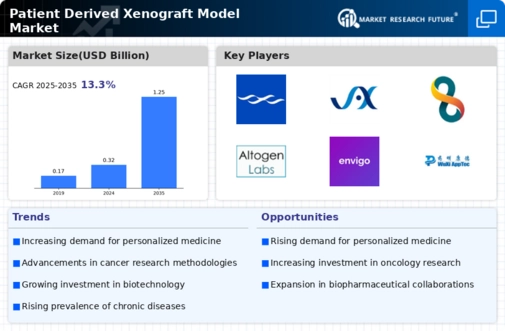Patient Derived Xenograft Model Size
Patient Derived Xenograft Model Market Growth Projections and Opportunities
By 2032, the patient-derived xenograft model market will be estimated to reach USD 0.75 billion with a CAGR of 13.3%. This implies that the Patient-Derived Xenograft (PDX) Model Market is always in a state of flux due to numerous factors that impact its growth and development. Human tumor cells are engrafted into immunodeficient mice in order to create patient-derived xenograft models. These models are useful in characterizing cancer biology and providing treatment approaches before application on humans. The main driver behind this shift in The Patient-Derived Xenograft Model Market is the increasing demand for more patient like cancer models. Cell lines and other common models may not adequately represent the diversity and complexity of human tumors. To address this problem, it is possible to apply patient-derived xenografts conservation of biological aspects of the tumor as well as their microenvironment which are key considerations in enhancing their utility in cancer studies and drug discovery exercises.
Personalized treatment has changed the dynamics of PDX models market significantly. As personalized treatment becomes more common among patients with various types of cancers, there is an increased emphasis on developing models that faithfully replicate unique attributes present within each individual’s tumor mass. The efficacy of cancer therapies can then be evaluated using PDXs generated from actual tumors from such patients whose anticancer drugs have been tailored towards their specific genetic profile at molecular level.
One major factor influencing changes in the Patient-Derived Xenograft Model Market is search for effective treatments against malignancies. The role played by PDX models lies between basic research and clinical trials whereby potential therapeutics are tested within a milieu closer to those found inside a typical patient. PDX models have better applicability in drug research and development because they can predict patient response to therapy. This change in the operations of the market is due to the use of PDX models by pharmaceutical companies, biotech firms, and research institutions to evaluate efficacy and safety profiles of new cancer drugs.
The continuous research and development work that goes into it is very significant for the PDX Model Market. Researcher continue to work on improving and modifying PDX model techniques including engraftment efficiency, stability of these models as well as scaling them up. The reason why PDX models are valuable tools for simulating human cancer biology lies in their attempts at becoming more representative through inclusion of components from the immune system and tumor microenvironment. The quest for novel uses such as co-clinical trials and investigating dynamic responses of tumors towards drugs brought about by introduction of PDX models affects how this industry operates.
Competition among companies offering PDX model services is another key market driver. Companies offering PDX model services are taking several steps to enhance their status in the market. They include introduction of more models, making relationships and improving the way models are described. Although a wide range of basic research services are offered, this can be enhanced by improving engraftment methods, releasing new and better PDX models and introducing a greater variety of primary research approaches. This atmosphere encourages inventiveness. Every time new powerful PDX models for study and pharmaceutical groups emerge on the market.














Leave a Comment